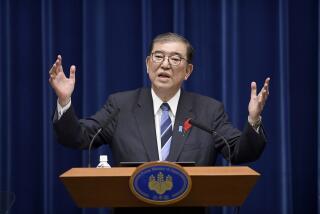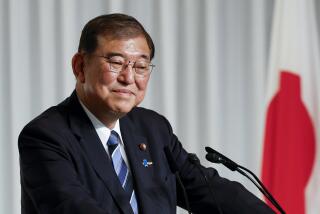The World : In Japanese Politics, Oil and Water Are Mixing
CAMBRIDGE, MASS. â Certainly, the inauguration of a Japanese Socialist prime minister atop a conservative Cabinet--including, of all people, Makiko Tanaka, daughter of the late conservative strongman and former premier Kakuei Tanaka --has to notch at least an eight on the 1994 bizarre-happening scale.
After all, Socialists and Liberal Democrats (conservative in political orientation despite the name) have been the oil and water of Japanese politics for 40 years. They have differed sharply over fundamental issues--defense, the constitution, fiscal policy and participation of Japanâs military forces in U.N.-sponsored peacekeeping operations. Furthermore, Japan is a consensus-driven society, conservatives dominate its politics, the Cold War is over and the Socialists hold just 15% of the seats in Parliament. So whatâs with a Socialist running the government?
âAbnormal,â âfarcical,â âlaughableâ were the most common reactions in Japan to the new lineup.
Socialist Tomiichi Murayama, famous in Japan for his craggy eyebrows, certainly raised more than a few when he unexpectedly defeated conservative retread and former Prime Minister Toshiki Kaifu for the nationâs top job. Murayamaâs Cabinet, formed the next day, included five geriatric Socialists (average age 70) in minor posts, 13 Liberal Democrats in the most powerful slots and two from the New Party Harbinger.
Whatâs going on? The same political deck has been shuffled and reshuffled so many times this past year--the Murayama government is the fourth--one wonders what game is being played, whoâs dealing, the stakes and whether Japan is ever playing with a full deck.
Americans project onto Japanese politics U.S.-style debates over principles, causes, purposes and policies. While analysts may want Japanese politics to be about these things, a desire furthered by the Japanese media, wishing does not make it so.
For example, what passes for a grand debate on Japanâs world role these days centers on the ideas of one politician, Ichiro Ozawa, onetime protege of strongman Noboru Takeshita. Ozawa bolted the Liberal Democratic Party, assumed the role of political reformer, preaching widely and loudly against irresponsibility and corruption in Japanese politics and urging Japan to become an activist ânormalâ country, even a âmini-superpowerâ in global affairs.
OK. Then recent political developments stem from this debate, with one camp supporting, the other opposing, Ozawaâs bold visions? Not at all.
These events reflect a continuing Japanese political evolution. Whatâs happening concerns politics, personalities, winning elections, gaining and maintaining political power.
Japanâs political-correctness code is another key to understanding the events. Deeply rooted in Japanese political culture are norms against self-serving, autocratic, overaggressive conduct. Ironically, Ozawa, renowned for his political instincts, skills at gauging votes and winning, was hoisted by his own petard. His âin your faceâ campaign to recruit Socialists and Liberal Democrats to Kaifuâs side âwent too far,â crossing the line of acceptability and alienating many key players. Anti-Ozawa sentiments were the glue binding the pro-Murayama coalition.
In the coming months, one pressing concern will be political stability. Not that Japan is at all unstable. There are no riots in the streets. The nation is scarcely in âcrisis.â But the past yearâs political turmoil has exacted a toll. Legislation has stalled, official trips have been canceled, key decisions are on hold. No immediate end seems in sight for the turbulence.
Indeed, there are serious doubts about the new government. Past coalition governments have not lasted. Another red light is public support for the new government--the third lowest recording ever. And, despite a display of unity, can the opposition-prone Socialists seize this chance to show leadership and purpose?
Still, the fledgling Murayama government has an edge over its predecessor coalitions. Among the reasons: its three-party coalition won nearly 55% of last Julyâs popular vote; savvy conservative politicians familiar with their ministries hold key portfolios; conservatives dominate the Cabinet, veteran politicians who have worked together via formal and informal networks; the Socialists are the top party in the upper house and a Socialist is speaker of the lower chamber; a workable right-center coalition has been in place for years, and while the Communists, with 15 lower-house seats, have become politically irrelevant, the Socialists have turned more pragmatic--a development that sharing power in the new government should hasten.
The immediate question seems less whether than when to hold a general election. Reform legislation aimed at overhauling campaign financing and restructuring election districts from multimember districts to a single-member constituency system passed the Diet in January and will go into effect this fall. The best guess is that the Murayama government will not call a quick election under the old system but will delay an election until redistricting becomes a political reality. While a U.S.-style two-party system may emerge from the next election, a three-party structure is as likely, and a multiparty system, with shifting coalitions and alliances, seems most probable.
For the moment, the anti-Liberal Democratic parties are in disarray. âConservative â is out. âNewâ is in, to the point of exhausting the Japanese vocabulary for expressing it. Perhaps the ânew life partyâ (Ozawaâs Shinseito) may metamorphose into the ânew-new life partyâ to satisfy the publicâs appetite.
Ideology matters less than ever, not because ideas are unimportant, but because the status-quo consensus is so solid on fundamentals--prosperity at home and stability abroad--that parties differ less and less on policy, particularly foreign policy, substance. It is hard to rally a country or a political party around the status quo. Despite the fervent wish for national purpose, identity, leadership and vision, these remain desirable, not feasible or realistic, goals in todayâs Japan. No crystal ball is needed to predict that what changes do occur will unfold through the gradualist, reactive, risk-minimizing processes of the past.
Its unorthodox composition notwithstanding, Japanâs new hybrid government is perhaps better equipped to address the economic and social issues facing Japan than were the ragtag coalitions running Japan since last July. One should bear in mind, too, that it took a decade for Japanese politics to stabilize after World War II. However transitional the arrangement may prove to be, by burying the hatchet and agreeing to share power, two former political rivals have demonstrated the depth of Japanâs political consensus and the decline of the ideological left as a factor in post-Cold War Japanese politics.*
More to Read
Sign up for Essential California
The most important California stories and recommendations in your inbox every morning.
You may occasionally receive promotional content from the Los Angeles Times.










